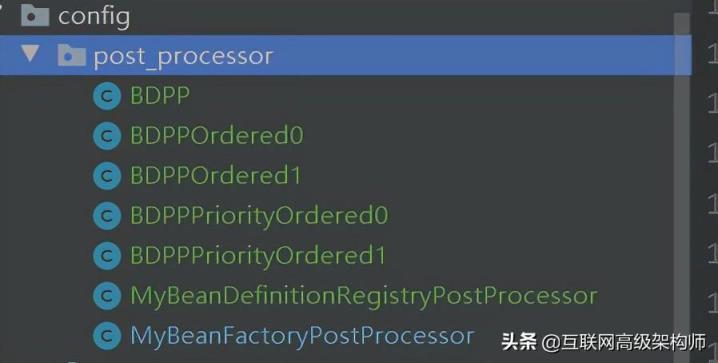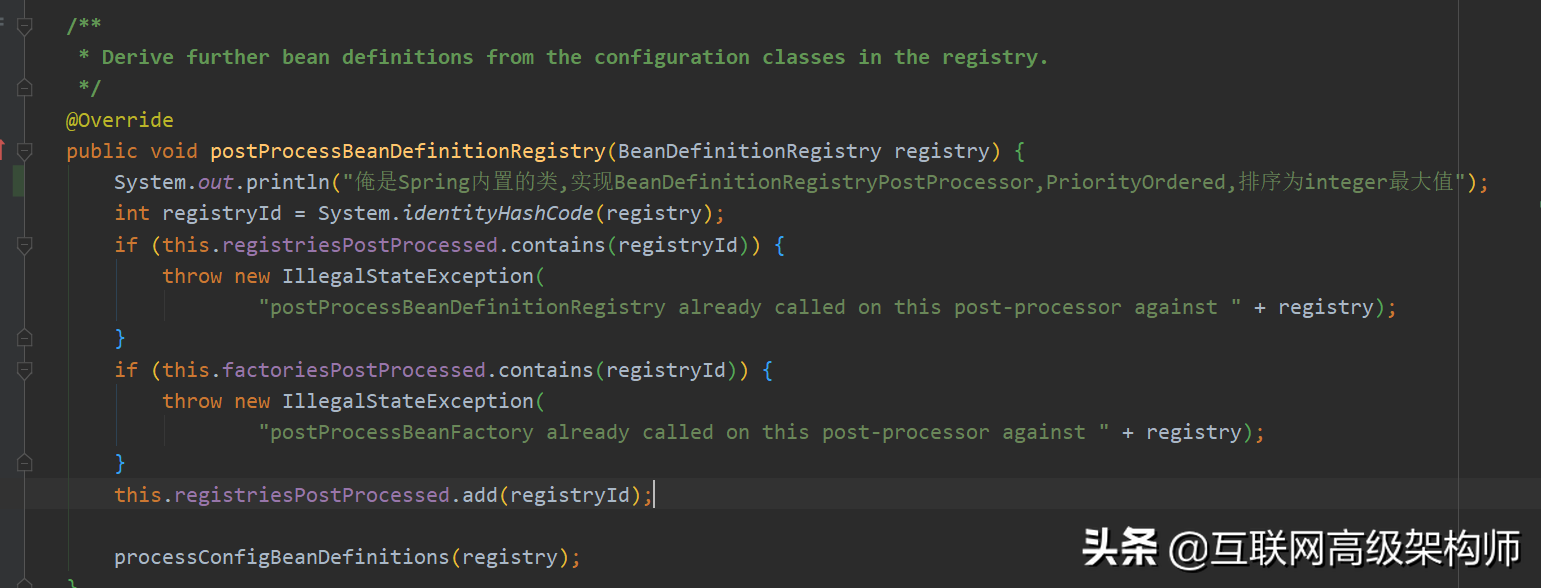BeanFactoryPostProcessor 接口是 Spring 提供的对 Bean 的扩展点,它的子接口是 BeanDefinitionRegistryPostProcessor
@FunctionalInterfacepublic interface BeanFactoryPostProcessor { void postProcessBeanFactory(ConfigurableListableBeanFactory beanFactory) throws BeansException;}
public interface BeanDefinitionRegistryPostProcessor extends BeanFactoryPostProcessor { void postProcessBeanDefinitionRegistry(BeanDefinitionRegistry registry) throws BeansException;}
复制代码
BeanFactoryPostProcessor 简单使用
BeanFactoryPostProcessor 的执行时机是在 Spring 扫描完成后,Bean 初始化前,当我们实现 BeanFactoryPostProcessor 接口,可以在 Bean 的初始化之前对 Bean 进行属性的修改
@Componentpublic class A {}
@Componentpublic class MyBeanFactoryPostProcessor implements BeanFactoryPostProcessor { @Override public void postProcessBeanFactory(ConfigurableListableBeanFactory beanFactory) throws BeansException { BeanDefinition beanDefinition = beanFactory.getBeanDefinition("a"); beanDefinition.setScope("prototype"); }}
@Configuration@ComponentScan("com.jame")public class Myconfig {}
public class MyTest { public static void main(String[] args) { AnnotationConfigApplicationContext context = new AnnotationConfigApplicationContext(Myconfig.class); A a = context.getBean(A.class); A a1 = context.getBean(A.class); System.out.println(a==a1); }}
复制代码
输出结果为:
上面的例子我们将 A 的 BeanDefinition 的 scope 设置为原型,默认没有设置 scope 的情况下 bean 的 scope 都是单例,也就是说我们成功的修改了 A 对象的 beanDefinition,能修改的属性不止这一个,还有是否懒加载,初始化方法名称,设置属性等等
而它的子类 BeanDefinitionRegistryPostProcessor 可以对 spring 容器中的 BeanDefinition 进行操作
不了解 BeanDefinition 的可以先简单理解为包装 Java 类的一个类,例如我们给类设置的是否单例,是否懒加载这些信息都需要存储,而 spring 就创建一个 BeanDefinition,用来存储除了 java 类以外的其他信息
BeanDefinitionRegistryPostProcessor 简单使用
@Componentpublic class A {}
public class B {}
@Componentpublic class MyBeanDefinitionRegistryPostProcessor implements BeanDefinitionRegistryPostProcessor {
@Override public void postProcessBeanDefinitionRegistry(BeanDefinitionRegistry registry) throws BeansException { RootBeanDefinition beanDefinition = new RootBeanDefinition(B.class); registry.registerBeanDefinition("b",beanDefinition); registry.removeBeanDefinition("a"); }
@Override public void postProcessBeanFactory(ConfigurableListableBeanFactory beanFactory) throws BeansException { }}
@Configuration@ComponentScan("com.jame")public class Myconfig {}
public class MyTest { public static void main(String[] args) { AnnotationConfigApplicationContext context = new AnnotationConfigApplicationContext(Myconfig.class); B b = context.getBean(B.class); System.out.println(b); A a = context.getBean(A.class); }}
复制代码
输出结果:
com.jame.pojo.B@2ac1fdc4Exception in thread "main" org.springframework.beans.factory.NoSuchBeanDefinitionException: No qualifying bean of type 'com.jame.pojo.A' available......
复制代码
上面的代码中我们对 A 类加上了 @Component,B 类什么都没有加,结果应该是 A 获取到正常输出,然后获取 B 时报错找不到,但是结果恰恰相反,因为我们在 MyBeanDefinitionRegistryPostProcessor 类中对 Spring 管理的 Bean 进行了修改,新增了一个 B 的 BeanDefinition,删除了 A 的 BeanDefinition,所以结果就如上面呈现的那样完成了上面的简单使用案例接下来就开始看 Spring 的执行原理是什么
源码分析
首先第一步要知道什么时候执行的上面的代码,为了方便就不将查找过程粘贴出来了,可以在实现类中输出句话,Debug 看看是在那个方法中输出的
public AnnotationConfigApplicationContext(Class<?>... componentClasses) { this(); register(componentClasses); refresh();}
复制代码
进入 refresh 方法
@Overridepublic void refresh() throws BeansException, IllegalStateException { ...... try { // Allows post-processing of the bean factory in context subclasses. postProcessBeanFactory(beanFactory);
// Invoke factory processors registered as beans in the context. invokeBeanFactoryPostProcessors(beanFactory);
// Register bean processors that intercept bean creation. registerBeanPostProcessors(beanFactory); ........ }}
复制代码
进入 invokeBeanFactoryPostProcessors 方法
public static void invokeBeanFactoryPostProcessors( ConfigurableListableBeanFactory beanFactory, List<BeanFactoryPostProcessor> beanFactoryPostProcessors) {
Set<String> processedBeans = new HashSet<>();
if (beanFactory instanceof BeanDefinitionRegistry) { BeanDefinitionRegistry registry = (BeanDefinitionRegistry) beanFactory; List<BeanFactoryPostProcessor> regularPostProcessors = new ArrayList<>(); List<BeanDefinitionRegistryPostProcessor> registryProcessors = new ArrayList<>();
for (BeanFactoryPostProcessor postProcessor : beanFactoryPostProcessors) { if (postProcessor instanceof BeanDefinitionRegistryPostProcessor) { BeanDefinitionRegistryPostProcessor registryProcessor = (BeanDefinitionRegistryPostProcessor) postProcessor; registryProcessor.postProcessBeanDefinitionRegistry(registry); registryProcessors.add(registryProcessor); } else { regularPostProcessors.add(postProcessor); } } List<BeanDefinitionRegistryPostProcessor> currentRegistryProcessors = new ArrayList<>();
String[] postProcessorNames = beanFactory.getBeanNamesForType(BeanDefinitionRegistryPostProcessor.class, true, false);
for (String ppName : postProcessorNames) { if (beanFactory.isTypeMatch(ppName, PriorityOrdered.class)) { currentRegistryProcessors.add(beanFactory.getBean(ppName, BeanDefinitionRegistryPostProcessor.class)); processedBeans.add(ppName); } } sortPostProcessors(currentRegistryProcessors, beanFactory); registryProcessors.addAll(currentRegistryProcessors); invokeBeanDefinitionRegistryPostProcessors(currentRegistryProcessors, registry); currentRegistryProcessors.clear();
postProcessorNames = beanFactory.getBeanNamesForType(BeanDefinitionRegistryPostProcessor.class, true, false); for (String ppName : postProcessorNames) { if (!processedBeans.contains(ppName) && beanFactory.isTypeMatch(ppName, Ordered.class)) { currentRegistryProcessors.add(beanFactory.getBean(ppName, BeanDefinitionRegistryPostProcessor.class)); processedBeans.add(ppName); } } sortPostProcessors(currentRegistryProcessors, beanFactory); registryProcessors.addAll(currentRegistryProcessors); invokeBeanDefinitionRegistryPostProcessors(currentRegistryProcessors, registry); currentRegistryProcessors.clear(); boolean reiterate = true; while (reiterate) { reiterate = false; postProcessorNames = beanFactory.getBeanNamesForType(BeanDefinitionRegistryPostProcessor.class, true, false); for (String ppName : postProcessorNames) { if (!processedBeans.contains(ppName)) { currentRegistryProcessors.add(beanFactory.getBean(ppName, BeanDefinitionRegistryPostProcessor.class)); processedBeans.add(ppName); reiterate = true; } } sortPostProcessors(currentRegistryProcessors, beanFactory); registryProcessors.addAll(currentRegistryProcessors); invokeBeanDefinitionRegistryPostProcessors(currentRegistryProcessors, registry); currentRegistryProcessors.clear(); }
invokeBeanFactoryPostProcessors(registryProcessors, beanFactory); invokeBeanFactoryPostProcessors(regularPostProcessors, beanFactory); } else { invokeBeanFactoryPostProcessors(beanFactoryPostProcessors, beanFactory); }
String[] postProcessorNames = beanFactory.getBeanNamesForType(BeanFactoryPostProcessor.class, true, false);
List<BeanFactoryPostProcessor> priorityOrderedPostProcessors = new ArrayList<>(); List<String> orderedPostProcessorNames = new ArrayList<>(); List<String> nonOrderedPostProcessorNames = new ArrayList<>(); for (String ppName : postProcessorNames) { if (processedBeans.contains(ppName)) { } else if (beanFactory.isTypeMatch(ppName, PriorityOrdered.class)) { priorityOrderedPostProcessors.add(beanFactory.getBean(ppName, BeanFactoryPostProcessor.class)); } else if (beanFactory.isTypeMatch(ppName, Ordered.class)) { orderedPostProcessorNames.add(ppName); } else { nonOrderedPostProcessorNames.add(ppName); } }
sortPostProcessors(priorityOrderedPostProcessors, beanFactory); invokeBeanFactoryPostProcessors(priorityOrderedPostProcessors, beanFactory);
List<BeanFactoryPostProcessor> orderedPostProcessors = new ArrayList<>(); for (String postProcessorName : orderedPostProcessorNames) { orderedPostProcessors.add(beanFactory.getBean(postProcessorName, BeanFactoryPostProcessor.class)); } sortPostProcessors(orderedPostProcessors, beanFactory); invokeBeanFactoryPostProcessors(orderedPostProcessors, beanFactory);
List<BeanFactoryPostProcessor> nonOrderedPostProcessors = new ArrayList<>(); for (String postProcessorName : nonOrderedPostProcessorNames) { nonOrderedPostProcessors.add(beanFactory.getBean(postProcessorName, BeanFactoryPostProcessor.class)); } invokeBeanFactoryPostProcessors(nonOrderedPostProcessors, beanFactory); beanFactory.clearMetadataCache(); }
复制代码
来看最上面定义
Set<String> processedBeans = new HashSet<>();
复制代码
这个也很好理解,存放已经执行完的 BeanFactoryPostProcessor 名字,防止重复执行
if (beanFactory instanceof BeanDefinitionRegistry) { BeanDefinitionRegistry registry = (BeanDefinitionRegistry) beanFactory;
//存放直接实现BeanFactoryPostProcessor,处理过/找到的实现类 List<BeanFactoryPostProcessor> regularPostProcessors = new ArrayList<>();
//存放直接实现BeanDefinitionRegistryPostProcessor,处理过/找到的实现类 List<BeanDefinitionRegistryPostProcessor> registryProcessors = new ArrayList<>();
for (BeanFactoryPostProcessor postProcessor : beanFactoryPostProcessors) { if (postProcessor instanceof BeanDefinitionRegistryPostProcessor) { BeanDefinitionRegistryPostProcessor registryProcessor = (BeanDefinitionRegistryPostProcessor) postProcessor; registryProcessor.postProcessBeanDefinitionRegistry(registry); registryProcessors.add(registryProcessor); } else { regularPostProcessors.add(postProcessor); } }
复制代码
来看第一个 if 判断,判断传入的 BeanFactory 是否是 BeanDefinitionRegistry 类型,大部分情况都是,我们先默认它一直为 true
那么上面定义两个集合用来存放已经处理过的实现类
下面这个 for 循环只有通过 api 来设置的 BeanFactoryPostProcessor 才会有值,什么意思呢?看下面
AnnotationConfigApplicationContext context = new AnnotationConfigApplicationContext(Myconfig.class);context.addBeanFactoryPostProcessor(new MyBeanFactoryPostProcessor());
复制代码
为什么没有呢?因为我们的代码运行顺序的问题,来看上面的使用代码,是先 new AnnotationConfigApplicationContext(MyConfig.class)
而在它的构造中就已经调用 refresh->invokeBeanFactoryPostProcessors->invokeBeanFactoryPostProcessors 方法了
而我们 debug 时候还没有走到 context.addBeanFactoryPostProcessor(new MyBeanFactoryPostProcessor());方法,所以为空
那怎么使用?我们仔细来看 AnnotationConfigApplicationContext 的构造
public AnnotationConfigApplicationContext(Class<?>... componentClasses) { this(); register(componentClasses); refresh();}
复制代码
里面就 3 个方法,调自己无参,register,refresh,而执行 invokeBeanFactoryPostProcessors 在 refresh 方法中,也就是说我们可以在 refresh 方法前进行注册即可
AnnotationConfigApplicationContext context = new AnnotationConfigApplicationContext(); context.register(Myconfig.class); context.addBeanFactoryPostProcessor(new MyBeanFactoryPostProcessor()); context.refresh();
复制代码
这样,我们就能在 refresh 方法前进行手动调用 api 的方式添加
继续往下
if (postProcessor instanceof BeanDefinitionRegistryPostProcessor) { BeanDefinitionRegistryPostProcessor registryProcessor = (BeanDefinitionRegistryPostProcessor) postProcessor; registryProcessor.postProcessBeanDefinitionRegistry(registry); registryProcessors.add(registryProcessor);} else { regularPostProcessors.add(postProcessor);}
复制代码
判断是 BeanDefinitionRegistryPostProcessor 类型,如果是,则直接执行.否则添加到集合,还记得这个集合吗在最外层的 if 中
if (beanFactory instanceof BeanDefinitionRegistry) { BeanDefinitionRegistry registry = (BeanDefinitionRegistry) beanFactory;
//存放直接实现BeanFactoryPostProcessor,处理过/找到的实现类 List<BeanFactoryPostProcessor> regularPostProcessors = new ArrayList<>();
//存放直接实现BeanDefinitionRegistryPostProcessor,处理过/找到的实现类 List<BeanDefinitionRegistryPostProcessor> registryProcessors = new ArrayList<>(); ......}
复制代码
如果不是则添加到 regularPostProcessors 集合,为什么这个类型不执行因为和 Spring 的执行顺序有关,等到最后在说
从 List currentRegistryProcessors = new ArrayList<>();创建这个集合开始向下看
List<BeanDefinitionRegistryPostProcessor> currentRegistryProcessors = new ArrayList<>();
String[] postProcessorNames = beanFactory.getBeanNamesForType(BeanDefinitionRegistryPostProcessor.class, true, false);
for (String ppName : postProcessorNames) { if (beanFactory.isTypeMatch(ppName, PriorityOrdered.class)) { currentRegistryProcessors.add(beanFactory.getBean(ppName, BeanDefinitionRegistryPostProcessor.class)); processedBeans.add(ppName); }}sortPostProcessors(currentRegistryProcessors, beanFactory);registryProcessors.addAll(currentRegistryProcessors);invokeBeanDefinitionRegistryPostProcessors(currentRegistryProcessors, registry);currentRegistryProcessors.clear();
复制代码
首先这个集合干啥的:用来存放当前需要执行的 BeanDefinitionRegistryPostProcessor
存放需要执行的 BeanDefinitionRegistryPostProcessor 的好理解,那什么叫做当前的???
提前说一下,这个集合是在下面复用的,当前的就是当前正在执行的 BeanDefinitionRegistryPostProcessor 类型是一类的,先往下看,一会再解释
首先它创建一个字符串数组来接收 beanFactory.getBeanNamesForType 的返回参数,简单说下这个方法的作用
从 BeanDefinitionNames 中寻找类型为传入类型的 BeanDefinition 的名称
调用链为:DefaultListableBeanFactory.getBeanNamesForType->DefaultListableBeanFactory.doGetBeanNamesForType,有兴趣可以自己去看看
那我们 debug 来看看获取到类型是 BeanDefinitionRegistryPostProcessor 的 beanName 都有谁
那么继续向下
if (beanFactory.isTypeMatch(ppName, PriorityOrdered.class)) 检查传入的 PostProcessorName 的 BenaDefinition 是否符合 PriorityOrdered.class,当然该方法的作用不止于此,我们现在只分析有关的
PriorityOrdered 是一个排序的接口,它的父类是 Ordered,谁的值越小越先调用,先简单了解下即可,不是本章重点
public interface PriorityOrdered extends Ordered {}
public interface Ordered { int HIGHEST_PRECEDENCE = Integer.MIN_VALUE; int LOWEST_PRECEDENCE = Integer.MAX_VALUE; int getOrder();}
复制代码
留个疑问,这个 BeanDefinition 什么时候进来的?先继续看代码整体返回 true 进入判断
currentRegistryProcessors.add(beanFactory.getBean(ppName, BeanDefinitionRegistryPostProcessor.class));
复制代码
主要重点在 getBean 方法,以后有机会在单独写篇 getBean 的,简单理解为从 Spring 的容器中获取类,如果不存在则从 BeanDefinitionMap 中找到对应 BeanDefinition,然后实例化返回
那么假设我们已经获取到了实例化后的 java 对象,它是谁呢?debug
请记住这个类 ConfigurationClassPostProcessor
之后将当前类的名称存放到已经处理过的 set 中,在该方法的最上面
//储存已经完成处理的BeanFactoryPostProcessor名字Set<String> processedBeans = new HashSet<>();
复制代码
之后调用排序方法,然后把已经处理过的 BeanFactoryPostProcessor 存放到 List
//存放直接实现BeanDefinitionRegistryPostProcessor,处理过的实现类List<BeanDefinitionRegistryPostProcessor> registryProcessors = new ArrayList<>();
复制代码
我们重点来看 invokeBeanDefinitionRegistryPostProcessors(currentRegistryProcessors, registry);方法
private static void invokeBeanDefinitionRegistryPostProcessors( Collection<? extends BeanDefinitionRegistryPostProcessor> postProcessors, BeanDefinitionRegistry registry) { for (BeanDefinitionRegistryPostProcessor postProcessor : postProcessors) { postProcessor.postProcessBeanDefinitionRegistry(registry); }}
复制代码
上面找到的 ConfigurationClassPostProcessor 是重中之重,Spring 的扫描就是这个类中完成的,何以证明?Debug
我们来看 beanFactory 中的 BeanDefinitionMap 数量即可
关于 Spring 的扫描以后有机会写一篇
然后清空当前正在执行的 List 集合,继续向下
postProcessorNames = beanFactory.getBeanNamesForType(BeanDefinitionRegistryPostProcessor.class, true, false);for (String ppName : postProcessorNames) { //这里判断如果在存储已经完成的集合中没有找到当前的BeanDefinitionRegistryPostProcessor //也就是说明这个还没有被执行过,那么放入当前执行的集合中进行下一步操作 if (!processedBeans.contains(ppName) && beanFactory.isTypeMatch(ppName, Ordered.class)) { currentRegistryProcessors.add(beanFactory.getBean(ppName, BeanDefinitionRegistryPostProcessor.class)); processedBeans.add(ppName); }}sortPostProcessors(currentRegistryProcessors, beanFactory);registryProcessors.addAll(currentRegistryProcessors);//一样的代码,执行postProcessBeanFactory方法invokeBeanDefinitionRegistryPostProcessors(currentRegistryProcessors, registry);currentRegistryProcessors.clear();
复制代码
发现了什么,代码和上面的很像,那么我们不在赘述,直接简单说一下重点
if (!processedBeans.contains(ppName) && beanFactory.isTypeMatch(ppName, Ordered.class))
复制代码
判断除了已经处理过的,防止重复执行,然后就是判断类型,上面的类型是 PriorityOrdered 现在是 Ordered
那么再来看
currentRegistryProcessors.add(beanFactory.getBean(ppName, BeanDefinitionRegistryPostProcessor.class));
复制代码
而这个集合就是刚才定义的存放"当前处理"的集合
List<BeanDefinitionRegistryPostProcessor> currentRegistryProcessors = new ArrayList<>();
复制代码
什么叫当前处理,在最开始执行的时候,这个集合存放的都是实现 PriorityOrdered 接口的类,对于上面来说,"当前处理的"就是实现 PriotyOrdered 类,然后代码执行到 currentRegistryProcessors.clear();那么对于实现 PriorityOrdered 接口的类来说,"当前处理"的这个集合,已经不是存放 PriorityOrdered 接口的实现类了
而到了这里,这个 list 中只存放 Ordered 类型的,那么"当前处理的"就指的是实现 Ordered 接口的类,因为它这个集合是好多地方复用的,所以叫做"当前处理"集合
那么下面的代码应该能看明白吧,上面处理了实现 PriorityOrdered,Ordered 的 BeanDefinitionRegistryPostProcessor,都执行完了最后执行没有实现两者的 BeanDefinitionRegistryPostProcessor
boolean reiterate = true;while (reiterate) { reiterate = false; postProcessorNames = beanFactory.getBeanNamesForType(BeanDefinitionRegistryPostProcessor.class, true, false); for (String ppName : postProcessorNames) { if (!processedBeans.contains(ppName)) { currentRegistryProcessors.add(beanFactory.getBean(ppName, BeanDefinitionRegistryPostProcessor.class)); processedBeans.add(ppName); reiterate = true; } } sortPostProcessors(currentRegistryProcessors, beanFactory); registryProcessors.addAll(currentRegistryProcessors); invokeBeanDefinitionRegistryPostProcessors(currentRegistryProcessors, registry); currentRegistryProcessors.clear();}
复制代码
那么这里可能有个疑问
registryProcessors.addAll(currentRegistryProcessors);invokeBeanDefinitionRegistryPostProcessors(currentRegistryProcessors, registry);
复制代码
这不是执行过了吗,为啥还要放集合?请注意,当前找的接口是 BeanDefinitionRegistryPostProcessor 的实现类,而不是 BeanFactoryPostProcessor,那么一个简单的 java 基础问题,一个类实现了 A 接口,而 A 接口又继承 B 接口,请问这个类需要实现 B 接口定义的方法吗,答案是肯定的,那么上面的只是执行 BeanDefinitionRegistryPostProcessor 接口中定义的方法,所以来看后两行就一目了然了
//为什么要传入已经执行过的BeanDefinitionRegisterPostProcess的集合?//因为我们自定义的类实现了BeanDefinitionRegisterPostProcess这个接口//而这个接口又继承了BeanFactoryPostProcess,那么我们不仅要实现子类的方法,还要实现父类的方法//而在上面的处理仅仅调用了子类的方法,所以又在这里调用一次父类的方法invokeBeanFactoryPostProcessors(registryProcessors, beanFactory);invokeBeanFactoryPostProcessors(regularPostProcessors, beanFactory);
复制代码
好的,到此为止,使用 Api 添加的 PostProcessor 完成,但是有个小问题,发现了吗,每次 postProcessorNames 都是重新获取一次,为什么不获取一次然后一直使用呢?
回过头我们来看开始使用 BeanDefinitionRegistryPostProcessor 的简单使用案例,假设实现 PriorityOrdered 接口的类在调用完 postProcessBeanDefinitionRegistry 方法对 bean 的数量进行了修改,那么下面的操作获取的数据都不是最新的,为了解决这个问题所以每次操作都重新获取一遍
继续向下走,下面的代码就是我们通过扫描或 xml 找到的 BeanFactoryPostProcessor 实现类
String[] postProcessorNames = beanFactory.getBeanNamesForType(BeanFactoryPostProcessor.class, true, false);
// Separate between BeanFactoryPostProcessors that implement PriorityOrdered,// Ordered, and the rest.//分别是存放实现了priorityOrdered接口,Ordered接口,和没有实现Ordered接口的名称集合List<BeanFactoryPostProcessor> priorityOrderedPostProcessors = new ArrayList<>();List<String> orderedPostProcessorNames = new ArrayList<>();List<String> nonOrderedPostProcessorNames = new ArrayList<>();for (String ppName : postProcessorNames) { if (processedBeans.contains(ppName)) { // skip - already processed in first phase above } else if (beanFactory.isTypeMatch(ppName, PriorityOrdered.class)) { priorityOrderedPostProcessors.add(beanFactory.getBean(ppName, BeanFactoryPostProcessor.class)); } else if (beanFactory.isTypeMatch(ppName, Ordered.class)) { orderedPostProcessorNames.add(ppName); } else { nonOrderedPostProcessorNames.add(ppName); }}
// First, invoke the BeanFactoryPostProcessors that implement PriorityOrdered.sortPostProcessors(priorityOrderedPostProcessors, beanFactory);invokeBeanFactoryPostProcessors(priorityOrderedPostProcessors, beanFactory);
// Next, invoke the BeanFactoryPostProcessors that implement Ordered.List<BeanFactoryPostProcessor> orderedPostProcessors = new ArrayList<>();for (String postProcessorName : orderedPostProcessorNames) { orderedPostProcessors.add(beanFactory.getBean(postProcessorName, BeanFactoryPostProcessor.class));}sortPostProcessors(orderedPostProcessors, beanFactory);invokeBeanFactoryPostProcessors(orderedPostProcessors, beanFactory);
// Finally, invoke all other BeanFactoryPostProcessors.List<BeanFactoryPostProcessor> nonOrderedPostProcessors = new ArrayList<>();for (String postProcessorName : nonOrderedPostProcessorNames) { nonOrderedPostProcessors.add(beanFactory.getBean(postProcessorName, BeanFactoryPostProcessor.class));}invokeBeanFactoryPostProcessors(nonOrderedPostProcessors, beanFactory);
复制代码
下面的代码就比较简单了,就简单写下
首先还是通过 beanFactory.getBeanNamesForType(BeanFactoryPostProcessor.class, true, false);获取类型为 BeanFactoryPostProcessor 的实现类名称,然后依次判断实现了 PriorityOrdered 接口了吗,实现 Ordered 接口了吗,还是两个都没实现
分别放到对应的集合中,随后顺序执行
我们来捋一下执行的顺序
通过 Api 添加实现 BeanDefinitionRegistryPostProcessor 的类
Spring 内置实现 PriorityOrdered 接口实现 Ordered 接口两者都没实现
通过 Api 添加实现 BeanFactoryPostProcessor 的类
执行通过扫描/xml 配置实现 BeanFactoryPostProcessor 和 PriorityOrdered 的类
执行通过扫描/xml 配置实现 BeanFactoryPostProcessor 和 Ordered 的类
执行通过扫描/xml 配置实现 BeanFactoryPostProcessor 的类
我们来写代码实际演示下
整体结构如下
@Componentpublic class BDPP implements BeanFactoryPostProcessor {
@Override public void postProcessBeanFactory(ConfigurableListableBeanFactory beanFactory) throws BeansException { System.out.println("俺啥排序接口都没实现"); }}
@Componentpublic class BDPPOrdered0 implements Ordered, BeanFactoryPostProcessor { @Override public int getOrder() {return 0;} @Override public void postProcessBeanFactory(ConfigurableListableBeanFactory beanFactory) throws BeansException { System.out.println("实现Ordered的BDPP,排序0"); }}
@Componentpublic class BDPPOrdered1 implements Ordered, BeanFactoryPostProcessor { @Override public int getOrder() {return 1;} @Override public void postProcessBeanFactory(ConfigurableListableBeanFactory beanFactory) throws BeansException { System.out.println("实现Ordered的BDPP,排序1"); }}
@Componentpublic class BDPPPriorityOrdered0 implements PriorityOrdered, BeanFactoryPostProcessor { @Override public int getOrder() {return 0;} @Override public void postProcessBeanFactory(ConfigurableListableBeanFactory beanFactory) throws BeansException { System.out.println("实现PriorityOrdered的BDPP,排序0"); }}
@Componentpublic class BDPPPriorityOrdered1 implements PriorityOrdered, BeanFactoryPostProcessor { @Override public int getOrder() {return 1;}
@Override public void postProcessBeanFactory(ConfigurableListableBeanFactory beanFactory) throws BeansException { System.out.println("实现PriorityOrdered的BDPP,排序1"); }}
public class MyBeanDefinitionRegistryPostProcessor implements BeanDefinitionRegistryPostProcessor {
@Override public void postProcessBeanDefinitionRegistry(BeanDefinitionRegistry registry) throws BeansException { System.out.println("Api添加的BeanDefinitionRegistryPostProcessor,我是该接口的方法"); } @Override public void postProcessBeanFactory(ConfigurableListableBeanFactory beanFactory) throws BeansException { System.out.println("Api添加的BeanDefinitionRegistryPostProcessor,我是父接口方法"); }}
public class MyBeanFactoryPostProcessor implements BeanFactoryPostProcessor { @Override public void postProcessBeanFactory(ConfigurableListableBeanFactory beanFactory) throws BeansException { System.out.println("Api添加的BeanFactoryPostProcessor"); }}
public static void main(String[] args) { AnnotationConfigApplicationContext context = new AnnotationConfigApplicationContext(); context.register(Myconfig.class); context.addBeanFactoryPostProcessor(new MyBeanFactoryPostProcessor()); context.addBeanFactoryPostProcessor(new MyBeanDefinitionRegistryPostProcessor()); context.refresh();}
复制代码
在 Spring 扫描的方法中添加一句话用于输出
其他 Spring 内置的就不再去添加了,我们来看结果
也就是说如果想在 Spring 完成扫描前对 Bean 进行一些操作可以实现 BeanDefinitionRegistryPostProcessor 接口并手动添加,而上面的输出也显示了,在同继承 PriorityOrdered 或 Ordered 的时候,值小的先执行
还有一个问题,我们在获取 BeanFactoryPostProcessor 时名称使用前每次都是重新获取一下,而在下面通过扫描或 Xml 配置的 BeanFactoryPostProcessor 时却只进行一次获取
String[] postProcessorNames = beanFactory.getBeanNamesForType(BeanFactoryPostProcessor.class, true, false);
复制代码
因为 BeanFactoryPostProcessor 接口只是对 bean 进行增强处理,不会进行删除新增的操作
回答上面的疑问:这个 ConfigurationClassPostProcessor 的 BeanDefinition 什么时候进来的
来看 new AnnotationConfigApplicationContext()的无参构造
public AnnotationConfigApplicationContext() { //spring内置的bd将在这里进行注册 this.reader = new AnnotatedBeanDefinitionReader(this); this.scanner = new ClassPathBeanDefinitionScanner(this);}
复制代码
public AnnotatedBeanDefinitionReader(BeanDefinitionRegistry registry, Environment environment) { Assert.notNull(registry, "BeanDefinitionRegistry must not be null"); Assert.notNull(environment, "Environment must not be null"); this.registry = registry; this.conditionEvaluator = new ConditionEvaluator(registry, environment, null); //这里 AnnotationConfigUtils.registerAnnotationConfigProcessors(this.registry);}
复制代码
public static Set<BeanDefinitionHolder> registerAnnotationConfigProcessors( BeanDefinitionRegistry registry, @Nullable Object source) { ..... if (!registry.containsBeanDefinition(CONFIGURATION_ANNOTATION_PROCESSOR_BEAN_NAME)) { RootBeanDefinition def = new RootBeanDefinition(ConfigurationClassPostProcessor.class); def.setSource(source); beanDefs.add(registerPostProcessor(registry, def, CONFIGURATION_ANNOTATION_PROCESSOR_BEAN_NAME)); } .......}
复制代码
还记得上面第一次通过 String[] postProcessorNames =beanFactory.getBeanNamesForType(BeanDefinitionRegistryPostProcessor.class, true, false);
来看 CONFIGURATION_ANNOTATION_PROCESSOR_BEAN_NAME 这个常量的值是啥
public static final String CONFIGURATION_ANNOTATION_PROCESSOR_BEAN_NAME = "org.springframework.context.annotation.internalConfigurationAnnotationProcessor";
复制代码
而它这个 if 判断是
@Overridepublic boolean containsBeanDefinition(String beanName) { Assert.notNull(beanName, "Bean name must not be null"); return this.beanDefinitionMap.containsKey(beanName);}
复制代码
就是说在初始化时,如果不存在则进行注册 beanDefinition,具体注册的方法从
beanDefs.add(registerPostProcessor(registry, def, CONFIGURATION_ANNOTATION_PROCESSOR_BEAN_NAME));
registry.registerBeanDefinition(beanName, definition);
DefaultListableBeanFactory.registerBeanDefinition 注册 beanDefinition 的方法,有兴趣可以点进去看看
作者:Jame
链接:https://www.cnblogs.com/sunankang/p/15488884.html






















评论